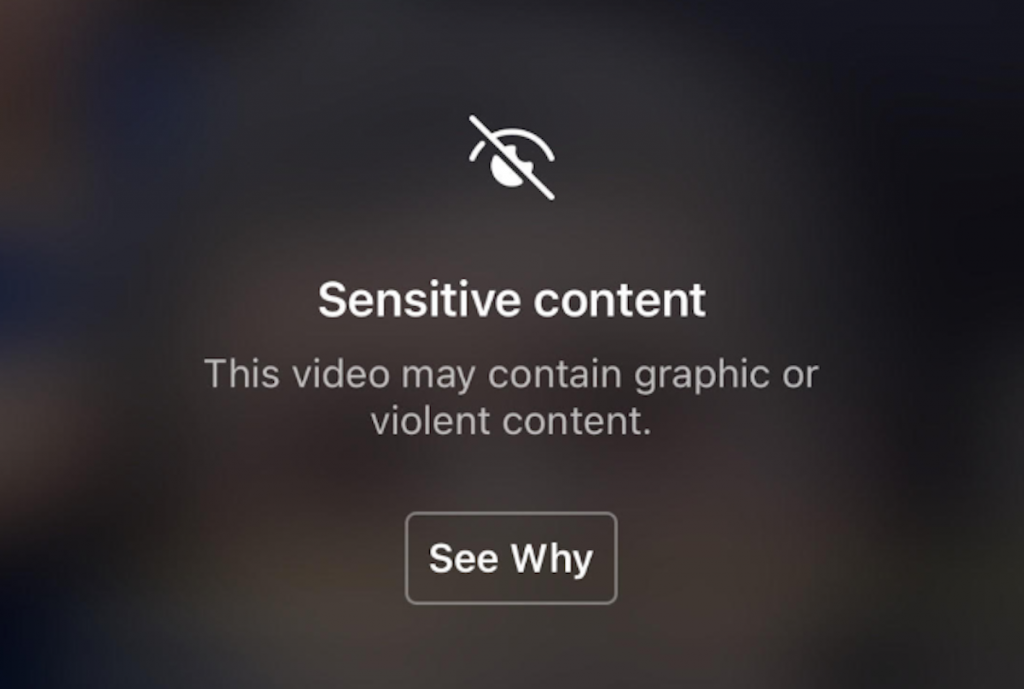
Trigger warnings are used to help individuals avoid or emotionally prepare for content that may cause them emotional or psychological distress (Cares et al., 2019; DeBonis, 2019; George & Hovey, 2020). Although well-intentioned, the evidence base and individual opinions towards the benefits of trigger warnings are mixed.
Trigger warnings can go by other names, such as content warnings, content advisories, and content notes, and are regularly used by TV and traditional media outlets (Charles et al., 2022). Their more recent adoption by online media channels and individual content creators has brought into question their appropriateness, helpfulness, and in some cases, their potential for harm.
Critics point to findings that suggest they introduce anticipatory anxiety (Bellet et al., 2018; Gainsburg & Earl, 2018), undermine the resilience of content consumers and their capacity to sit with distressing information, and over-sensitise individuals to challenging, but necessarily important, topics (Lukianoff and Haidt 2015; Bellet et al. 2018).
Others argue that they provide individuals with a sense of agency and allow them to make active choices about whether to engage with or avoid, certain types of content (Cares et al. 2019; George and Hovey 2020; DeBonis 2019).
With limited research, mixed findings, vast individual variability in views, and a lack of consensus for what constitutes a good trigger warning and when it is required, a recent meta-analysis of the efficacy of trigger warnings was a very welcome and timely addition to this ongoing debate (Bridgland et al., 2023).

Variations in the way content warnings have been defined, measured, and implemented make it difficult to compare their efficacy.
Methods
Studies investigating participant psychological or psychophysiological reactions or behaviours to trigger warnings were included in this meta-analysis. Trigger warnings had to specifically notify participants that the content they were about to view may elicit memories or emotions relevant to past experiences. Trigger warnings that were general in nature (e.g., PG-13 warnings) were excluded. Studies also had to measure outcomes relating to one or more of the following: response affect, avoidance, anticipatory affect, and educational outcomes (i.e., comprehension).
407 articles were initially identified as meeting the search criteria. After removing 171 duplicate papers, 236 abstracts were screened against the inclusion criteria. Of these 236 abstracts, only 20 studies were able to be included in the full-text screening.
The full-text screening identified gaps within some of these studies (i.e., provided warnings that did not meet the definition of a trigger warning as outlined within this review, and did not measure the same outcomes), resulting in a total of 12 studies that could be included in the meta-analysis. Extracted psychological and behavioural outcomes were then organised into four categories: anticipatory affect; avoidance; comprehension and response affect. A three-level meta-analysis with nested effects was then conducted.
Results
Each of the 12 included studies were published after 2018. Most studies used a single-session design where participants were randomised to receive a content warning or a control condition. The majority of studies also measured their primary outcomes immediately after participants were exposed to distressing content or a content warning (or both). The authors reported that included studies were predominantly conducted in WEIRD societies (Western, Educated, Industrialised, Rich, and Developed) and thus lacked diverse cultural perspectives. Most samples comprised trauma survivors: only two effect sizes in the meta-analysis excluded trauma survivors, and multiple studies exclusively examined trauma survivor experiences.
- Eleven of the twelve included studies were unanimous in their conclusion that trigger warnings did not have a meaningful impact on:
- participants’ emotional response to negative material (defined as ‘response affect’),
- avoidance behaviours (with some studies reporting that content warnings fostered more engagement, not less) or
- learning outcomes.
- Results also indicated that content warnings consistently led to a brief increase in distress due to participants anticipating distressing content (defined as ‘anticipatory anxiety’).
- Only one of the twelve studies refrained from concluding that content warnings are ineffective, and instead highlighted that there are various competing benefits and risk factors that are difficult to disentangle.
Overall, the results of this review do not support that content warnings are helpful, and they do not appear to assist individuals in emotionally preparing for, and avoiding, distressing content. This raises questions about if, when, and where content warnings are most helpful for different individuals.

Results suggest that content warnings are not as helpful as we think they are.
Conclusions
The findings from this meta-analysis provide a compelling argument that trigger warnings do not meaningfully impact emotional response to distressing material, behavioural avoidance, or understanding of the content being viewed. In fact, results suggest that sometimes content warnings increase anticipatory distress and result in a period of discomfort prior to exposure.
Although it is acknowledged that these findings have predominantly been drawn from western, non-clinical, adult samples and cannot be generalised to all individuals, the outcomes raise a number of important questions. Future areas of investigation should include the potential benefits of content warnings for cohorts with specific trauma experiences; how culture may influence the acceptability and impact of content warnings; as well as the differential impacts for specific groups such as neurodiverse individuals and young people. Further, the included studies only looked at immediate, short-term reactions to warnings. Little is known regarding the longer-term impacts and how cumulative exposure to distressing content (and in turn, content warnings) impacts individuals.
From the present meta-analysis, it can be concluded that for predominantly white adults in western, developed nations, content warnings serve little purpose. However, this cannot be the end of the conversation because many more individuals than were represented in this meta-analysis are exposed to distressing content regularly.

Future research must consider the differential impact of content warnings on individuals from black, ethnic, and indigenous backgrounds.
Strengths and limitations
This study was the first meta-analysis of the psychological effects of content warnings. The authors note that previous research findings have been mixed, and therefore, there is potential for proponents of either ‘side’ of the debate to only cite studies that support their views. As suicide prevention researchers focused on how young people use social media for suicide and self-harm related communication, we argue that this meta-analysis is an important scientific contribution to the literature, however, many questions remain unanswered with respect to the potential utility of content warnings.
Front of mind is the fact that anecdotally, many young people have told us that they think content warnings are helpful and they would prefer content warnings be used prior to being exposed to self-harm and suicide-related content online. On the one hand, this presents a challenging scenario where the perceptions and preferences of young people are in conflict with the evidence in this review. However, it is important to note that the studies included in this meta-analysis focused on adults, and developmental differences may play an important role in the usefulness of content warnings. When it comes to online exposure, young people are among those most likely to come across distressing content due to the amount of time they spend online, and the way current algorithms work on many popular platforms. As such, there is an urgent need for future studies to consider age-appropriate ways for giving young people the choice about the sort of content they engage with. Furthermore, the nature of this study meant that it did not include qualitative research into the views’ and perspectives of young people. It is possible that social media users may report experiencing content warnings as qualitatively helpful, even where increased anticipatory affect and mixed behavioural outcomes (e.g. avoidance or the ‘forbidden fruit’ effect) are identified. In fact, anticipatory anxiety may, at times, serve an important purpose. We argue that the views of social media users, and particularly young people, will be an essential addition to this conversation going forward.
Next, it is critical that culturally and linguistically diverse communities are invited to contribute to research into the impacts and benefits of content warnings. This is a limitation to the existing body of literature and thus the meta-analysis was not able to examine the differential impact of content warnings across cultural groups. For example, in Australia we know that warning viewers that they may be exposed to information about someone who has died is particularly important for many First Nations communities. For some Aboriginal and Torres Strait Islander Australians, being exposed to images or names of individuals who have died can not only cause distress but can also violate strongly held cultural prohibitions (AIATSIS, 2022). This is just one example of many nuanced and complex considerations that should be made when considering the use of content warnings and how their meaning and value may differ across cultures and communities.

Research needs to explore the impact of trigger warnings on children and young people, as developmental differences may influence their usefulness.
Implications for practice
Overall, we argue that the way distressing information is shared online is more important than whether or not a content warning is included. Content warnings have the potential to become a ‘tick-box exercise’ and may disincentivise users from sharing sensitive information in safe ways. For example, the #chatsafe guidelines (the world’s first guidelines developed to support young people to communicate safely online about self-harm and suicide) encourage young people to pause before posting and consider the information they are posting, and what the implications may be for themselves in the future and those that they care about. #chatsafe also encourages young people to avoid detailing methods of self-harm and suicide (what, how, where and when) and they are encouraged to follow this guidance regardless of whether a content warning is used. The recently updated #chatsafe guidelines step young people through how to share their stories of self-harm and suicide in safe and helpful ways for themselves and their online friends (Robinson et al., 2023). Considerations for how information about other topics can be shared safely would also contribute to safer online interactions, and reduce the responsibility placed upon content warnings to keep everyone safe.
Findings of this meta-analysis also support the importance of discussing online content in offline settings and in providing appropriate support to individuals exposed to harmful material. This is particularly important for clinicians, or those working with young people, when considering and discussing the nature and quantity of distressing online content young people are exposed to daily.
Finally, an important question remains relating to the language used when referring to trigger warnings – should it be content warnings, content notice, content advisory or another term? Some argue that the term ‘trigger warning’ denotes that the information being shared should be triggering or traumatic in some way, and this can perpetuate already highly stigmatised topics. Different terms are used in practice and throughout the literature, and it is important to understand the perspectives of community members who such content warnings are designed to assist. The perspectives of young people with lived experience of trauma should be paramount in this conversation.
The findings of this paper have made an important contribution to what needs to be an ongoing conversation. More nuanced understandings of where, when, and how content warnings support users to make conscious decisions about the information they share and consume online will contribute to safer interactions and ultimately ensure the safety of both content creators and consumers.

A much more nuanced understanding of where, when, and how content warnings support individuals is needed.
Useful links
- Mindframe guidelines
- #chatsafe guidelines
- #chatsafe examples of content warnings
- The Daily Aus podcast with Dr Zac Seidler
Statement of interests
Dr Louise La Sala, Mr Charlie Cooper and Professor Jo Robinson are researchers on the #chatsafe project, a program of work designed to support young people to communicate safely online about self-harm and suicide.
Links
Primary paper
Other references
Robinson J, Thorn P, McKay S, Hemming L, Battersby-Coulter R, Cooper C, Veresova M, Li A, Reavley N, Rice S, Lamblin M, Pirkis J, Reidenberg D, Harrison V, Skehan J, La Sala L. #chatsafe 2.0. updated guidelines to support young people to communicate safely online about self-harm and suicide: A Delphi expert consensus study. PLoS One. 2023 Aug 2;18(8):e0289494. doi: 10.1371/journal.pone.0289494.
AIATSIS (2022). Cultural sensitivity.
Bellet, B. W., Jones, P. J., & McNally, R. J. (2018). Trigger warning: Empirical evidence ahead. Journal of Behavior Therapy and Experimental Psychiatry, 61, 134–141.
Cares, A. C., Franklin, C. A., Fisher, B. S., & Bostaph, L. G. (2019). “They Were There for People Who Needed Them”: Student Attitudes Toward the Use of Trigger Warnings in Victimology Classrooms. Journal of Criminal Justice Education, 30(1), 22–45.
Charles, A., Hare-Duke, L., Nudds, H., Franklin, D., Llewellyn-Beardsley, J., Rennick-Egglestone, S., Gust, O., Ng, F., Evans, E., Knox, E., Townsend, E., Yeo, C., & Slade, M. (2022). Typology of content warnings and trigger warnings: Systematic review. PloS One, 17(5), e0266722.
DeBonis, K. (2019). Trigger Warnings in Medical Education. Academic Medicine: Journal of the Association of American Medical Colleges, 94(6), 749.
Gainsburg, I., & Earl, A. (2018). Trigger warnings as an interpersonal emotion-regulation tool: Avoidance, attention, and affect depend on beliefs. Journal of Experimental Social Psychology, 79, 252–263.
George, E., & Hovey, A. (2020). Deciphering the trigger warning debate: a qualitative analysis of online comments. Teaching in Higher Education, 25(7), 825–841.
Photo credits
- Photo by Andrew Neel on Unsplash
- Photo by Keagan Henman on Unsplash
- Photo by FlyD on Unsplash
